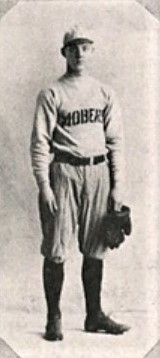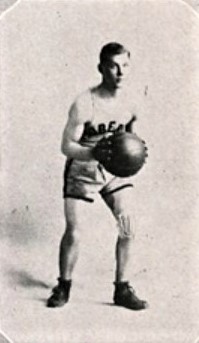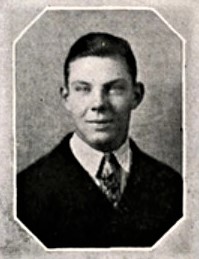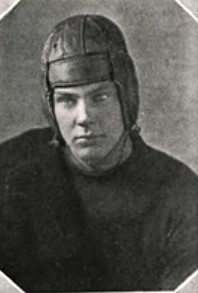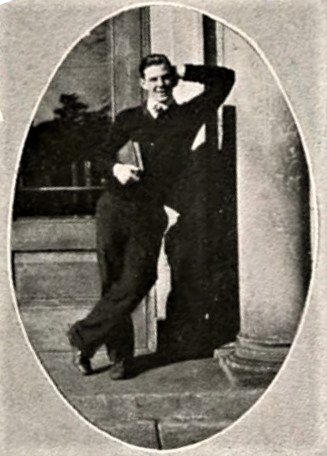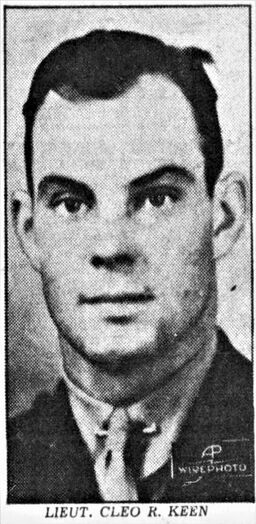CLEO R. KEEN, 1LT, USMC
Cleo Keen '32
Lucky Bag
From the 1932 Lucky Bag:
CLEO RAFTER KEEN
Moberly, Missouri
"Runt" "Pee Wee"
Some people from Missouri may have to be shown but Runt usually finds out for himself, and along some lines he is a regular Columbus. Pee Wee does lack length. A stick of dynamite is not very large—but what a myriad of things it can do when it's lit off! He loves his fun and is always in on any bull-sessions, sings, water fights or shower parties.
Pee Wee does use his power for some good purposes. In the fall, whenever his knee is in joint, he shows the boys what to do with a football, but he is always looking forward to spring, because Runt is a smoothy on the hot corner. He's also somewhat a swimmer, being wont to practice in fountains at two A. M.
Although sometimes close to the ragged edge, Pee Wee stays sat, sufficiently so that he does not have to worry a great deal.
Runt is pretty much a ladies' man, but he does not seem desirous of remaining in one place. He is just holding out 'til the right girl comes along and then look out!
"What, the 23rd, why, I can do that un myself."
Football 32; Basketball 32; Baseball 32, N; N Club; 2 P.O.
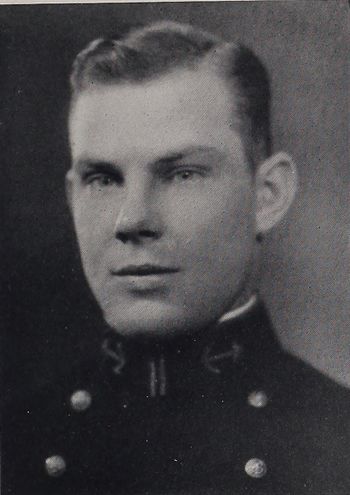
CLEO RAFTER KEEN
Moberly, Missouri
"Runt" "Pee Wee"
Some people from Missouri may have to be shown but Runt usually finds out for himself, and along some lines he is a regular Columbus. Pee Wee does lack length. A stick of dynamite is not very large—but what a myriad of things it can do when it's lit off! He loves his fun and is always in on any bull-sessions, sings, water fights or shower parties.
Pee Wee does use his power for some good purposes. In the fall, whenever his knee is in joint, he shows the boys what to do with a football, but he is always looking forward to spring, because Runt is a smoothy on the hot corner. He's also somewhat a swimmer, being wont to practice in fountains at two A. M.
Although sometimes close to the ragged edge, Pee Wee stays sat, sufficiently so that he does not have to worry a great deal.
Runt is pretty much a ladies' man, but he does not seem desirous of remaining in one place. He is just holding out 'til the right girl comes along and then look out!
"What, the 23rd, why, I can do that un myself."
Football 32; Basketball 32; Baseball 32, N; N Club; 2 P.O.
Loss
Cleo was lost on November 20, 1936 when the plane he was piloting crashed near Friendship, Maryland. The enlisted man aboard was also killed; both were stationed at Quantico, Virginia.
Other Information
From researcher Kathy Franz:
Cleo graduated from Moberly High School in 1927. (At times, his last name was spelled Keene.) Gym. 1; Football (halfback) 2, 3, 4; Lit. Society 2; Glee Club 2; Basketball (forward) 3, 4, Team 4; Baseball Team (short stop) 3, 4; Am. Hist. Club 3; Sr. Ath. Club 3; “M” Club 3, 4. Class Prophecy: Cleo and two classmates recently competed in the Olympic games, winning honors in all entries. In the Features section: Cleo was caught carrying a textbook around.
He attended one year at Moberly Junior College before entering the Naval Academy.
Cleo graduated from Marines Officers’ School at Philadelphia and the Naval Air School in Pensacola in April 1936. He served one year on the U. S. S. Northampton. In June 1933, he was assigned to the New York ship in San Pedro.
According to an AP report: “Flying low, and without great speed, the plane dipped down near the Southern High School, wobbled crazily and hit slantwise on its nose in a field on the farm of Miss Mary Estep.” A school teacher heard the engine falter and catch, and then it seemed to stop. He was flying a “B.G.”, 2-seated Great Lakes Bomber. The plane had recently been overhauled. The cause may have been a faulty motor.
Cleo was a pilot of a bombing squadron. He was engaged to Mary McDonald of Jefferson City.
From the Moberly Monitor-Index, September 8, 1930:
Cleo Keen, Moberly Boy, Tells of Interesting Work and Play as Student in Naval Academy
Athletic games, cruises in the air and on the sea, numerous dances and social affairs, strict discipline and work – Oh, so much work! – these are the experiences of a student in the United States Naval Academy at Annapolis, Md., says Cleo Keen, son of Mr. and Mrs. E. E. Keen, 902 Franklin street.
Keen, who is home on leave, has completed his first two years of work in the academy and is now on the football and basketball squads and a member of the baseball team.
The young Missourian placed second in the batting averages of the Intercollegiate League, hitting .381 and his stick helped the academy to finish its season with a record of no defeats in their league and victory in 19 of 22 games. Losses were carded from the Washington Senators, Yale and Duke.
Out Because of Injury
An injury to his knee while wrestling the first part of last year kept Keen out of the baseball lineup until the latter part of the season and then he was shifted from his regular position at short stop to the third base corner.
Although showing high signs of promise during his plebe year, Keen’s injury has also handicapped him in other sports. Keen was the sensation of the Plebe-Maryland frosh game his year and made the only touchdown for his team which won a 7-6 victory, but he has had to take training lightly since his hurt and is only on the squads now.
“We only go on one athletic tour in each sport each year except football, but whenever we do get away from school we have a gala time and the whole regiment is taken,” the second classman says.
Keen in describing life at the academy continues. “Life in the academy is a routine and studies are really hard. We have three classes daily in academic and a fourth period is set aside for drill. We study one hour, recite one hour and during the academic year are confined to our rooms approximately six hours a day. You have to get an education whether you want it or not and unless you do get it they either ram it down your neck or fire you out of the school.
“I enjoy the life a great deal. It is different from anything I have ever been through before and as I enjoy athletics I find every sort of sport known open to me.
On Long Cruise
“I have also been on one lengthy sea cruise. During the summer months the regiments of first and third classmen go on a cruise in foreign waters. I went on that cruise last year when we went to Barcelona, Naples, Rome, Vesuvius, Pompei, Capri, Gibraltar and Weymouth. We went in three ships and had leaves at Naples and Weymouth so that we could see Europe.
“The primary use of this cruise is to teach Annapolis students to handle big guns. Midshipmen (the fourth year men) navigate the ship and are overseers of the entire cruise, although the regular ship’s captain and main officers are really in control of the ship. The midshipmen really “hold the sack” because they have all the responsibilities.
“Members of the third class furnish the crew and they clean up the division. We overhauled, examined and studied the great engines getting a practical training course in their functions and construction while they were running. Every Annapolis graduate is a qualified electrical and aeronautical engineer,” Keen added.
“Last days of the cruise are taken up in battle practice at the southern drill grounds off Hampton Roads. A target is pulled along and we fire upon it at short range. It is seldom that more than two out of ten shots are missed.
Visit in Europe
“On these cruises we don’t have an awful lot to do although the fact that we are actually in an environment such as is presented here gives us much knowledge. We had lots of fun on our leaves and went all over Europe on them. Large social functions were given at Weymouth and Gibraltar and we got the keys to the city and nearly everything of interest was opened to us. Attractive society girls from all that vicinity were brought down and presented to us for partners.
“Immediately after the cruise, we got leaves of twenty-eight days and I came home.
“Taken as a whole the entire period of training in the academy is considerably stiffer than that of regular colleges and universities.
“The plebe year is really the hardest year of the four because of menial tasks demanded by the upperclassmen. The first year men do everything from being a personal valet to a secretary although such practices must be kept under cover as rules of the school forbid. All such affairs are given in a gentlemanly manner and are believed essential by the students as the plebes will get to understand what “rate” or authority means.
“Students obtain their first “rate” in their second year and after that sledding is much easier even though studies get harder all the time. A little over half of the entrants are lost by the wayside before they complete their courses.
Study Aviation
“I liked this summer’s period of instruction better than any time since I have been in the school. We were taught a general aeronautical course in which we tore down and assembled motors, examined materials and were up several hours a week. We took trips over Norfolk, Baltimore, Philadelphia and up and down the Chesapeake. I liked to fly more than anything else. The navy department has only recently inaugurated this branch and it hopes that all members of the 1930-31-32-33 classes will be aviators.
“After the expiration of leaves my classmates will return to the academy for another eight months of study. We will then become first classmen and will go on our second cruise at sea. This will be followed by another leave, another eight more weeks of study and then we will graduate with a commission as an ensign in the United States Navy.
Stress Social Training
“Social training is highly stressed at the academy. Two or three “hops,” formal dances, are given every month, twice a year the President and members of his cabinet inspect the school and first classmen hear after-dinner speeches once a week from greatest speakers of the present time.
“Every one in the academy is given dancing lessons as well as studies of etiquette. Partners at the dances are furnished from young women at Vassar, Goucher and other eastern girls’ schools. They come down to spend weekends and we take them sailing, to athletic events, which are held every week, as well as to dinners. The big social event of the year, however, is in the first of June during graduation. There is a big farewell ball and just one continual banquet in the mess hall.”
From the Moberly Monitor-Index, September 9, 1931:
[Cleo spoke to the Moberly Kiwanians at their noon luncheon. The annual summer cruise of 850 men were aboard two battleships, the Arkansas and the Wyoming. Cities visited included: Copenhagen, Denmark; Glasgow, Scotland; Cadiz, Seville and Madrid, Spain; Gibraltar; and Morocco.]
On their cruise across the Atlantic they went to the aid of the submarine Nautilus when they received a radio message that the sub was in distress on accounts of engine trouble and the rough sea. The two battleships “stood by” for a day and a half until the Nautilus was repaired and continued on its trip to the North Pole.
The training given the naval students on the cruise was divided into four periods of three weeks each. The first was given over to instruction in navigation, the second to engineering, the third to signal detail and the final three weeks to preparations for battle and firing practice.
From the Moberly Monitor-Index, September 21, 1934:
In an assembly Wednesday, Junior High students learned something about student life at the U. S. Naval Academy at Annapolis, when Lieutenant Cleo Keen (who used to be plain “Rut” Keen around here a few years ago) paid his former Alma Mater a visit.
Impressive in martial trappings, Lt. Keen sketched naval class routines. Said he: “When I was in school here, about eight years ago, sitting where you are now, I used to make my M’s and I’s and be pretty satisfied with them.
“Then I got to Annapolis. The first thing they told me was “There are two things you can do here. You can either learn your lessons – or we’ll choke ‘em down your throat.’”
A hundred or so of his listeners must have immediately decided the sometimes-complained-about Moberly system wasn’t so bad after all!
[While in town, Cleo also was guest at the Progressive Club’s weekly luncheon. Then on October 4, Cleo talked about the Marine Corps and life aboard ship to Progressive Club members.]
Keen said that organization and maintenance of the Marine Corps was due principally to the Monroe Doctrine. He explained that the Marines may land on any foreign soil to protect American lives and property without there being a declaration of war by this government. For the U. S. Army or navy forces to do this would be a violation of international treaties, he said.
Discussing “army discipline,” Keen said, “If all economic and social life in our nation was governed as well as the government’s military forces we would get along a lot better.”
Cleo was survived by his parents and his brother and is buried in Missouri.
Photographs
The "Register of Commissioned and Warrant Officers of the United States Navy and Marine Corps" was published annually from 1815 through at least the 1970s; it provided rank, command or station, and occasionally billet until the beginning of World War II when command/station was no longer included. Scanned copies were reviewed and data entered from the mid-1840s through 1922, when more-frequent Navy Directories were available.
The Navy Directory was a publication that provided information on the command, billet, and rank of every active and retired naval officer. Single editions have been found online from January 1915 and March 1918, and then from three to six editions per year from 1923 through 1940; the final edition is from April 1941.
The entries in both series of documents are sometimes cryptic and confusing. They are often inconsistent, even within an edition, with the name of commands; this is especially true for aviation squadrons in the 1920s and early 1930s.
Alumni listed at the same command may or may not have had significant interactions; they could have shared a stateroom or workspace, stood many hours of watch together, or, especially at the larger commands, they might not have known each other at all. The information provides the opportunity to draw connections that are otherwise invisible, though, and gives a fuller view of the professional experiences of these alumni in Memorial Hall.
October 1932
January 1933
April 1933
July 1933
October 1933
April 1934
July 1934
October 1934
1LT Ronald Boone '20 (Marine Corps Schools, Marine Barracks, Quantico, Virginia)
1LT Ralph Forsyth '22 (Fleet Marine Force, Marine Barracks, Quantico, Virginia)
2LT Chandler Johnson '29 (Marine Corps Schools, Marine Barracks, Quantico, Virginia)
January 1935
LT James Craig '22
LTjg John Duke '26
LTjg Ralph Smith '26
1LT Harold Bauer '30
LTjg Vernon Hain '31
LTjg Thomas Ashworth, Jr. '31
ENS Edward Allen '31
April 1935
LT James Craig '22
LTjg John Duke '26
LTjg Ralph Smith '26
LTjg Robert Coates '30
1LT Nicholas Pusel '30
1LT Harold Bauer '30
LTjg Vernon Hain '31
LTjg Thomas Ashworth, Jr. '31
ENS Edward Allen '31
October 1935
LT James Craig '22
LT Richard Moss '24
LTjg John Duke '26
1LT Ernest Pollock '28
LTjg William Pennewill '29
LTjg Robert Coates '30
1LT Nicholas Pusel '30
LTjg Gilbert Carpenter '30
LTjg Lance Massey '30
1LT Harold Bauer '30
January 1936
LT James Craig '22
LTjg John Duke '26
1LT Ernest Pollock '28
LTjg William Pennewill '29
LTjg Gilbert Carpenter '30
LTjg Lance Massey '30
April 1936
July 1936

The "category" links below lead to lists of related Honorees; use them to explore further the service and sacrifice of alumni in Memorial Hall.

